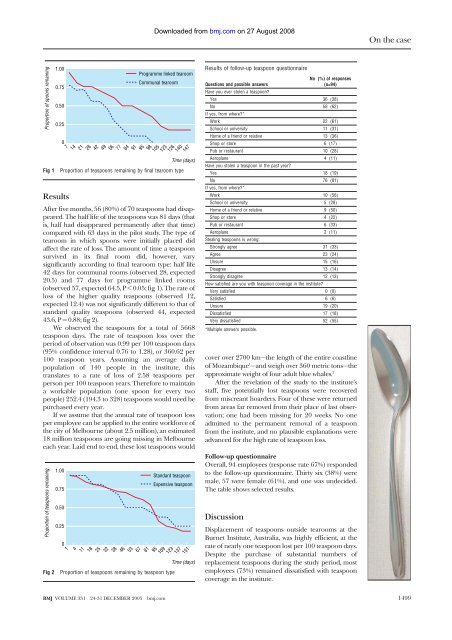teaspoons
teaspoons
teaspoons
- No tags were found...
Create successful ePaper yourself
Turn your PDF publications into a flip-book with our unique Google optimized e-Paper software.
Downloaded from bmj.com on 27 August 2008On the caseProportion of spoons remainingFig 11.000.750.500.25Results714212842495677849195980Programme linked tearoomCommunal tearoom105123126140147Time (days)Proportion of <strong>teaspoons</strong> remaining by final tearoom typeAfter five months, 56 (80%) of 70 <strong>teaspoons</strong> had disappeared.The half life of the <strong>teaspoons</strong> was 81 days (thatis, half had disappeared permanently after that time)compared with 63 days in the pilot study. The type oftearoom in which spoons were initially placed didaffect the rate of loss. The amount of time a <strong>teaspoons</strong>urvived in its final room did, however, varysignificantly according to final tearoom type: half life42 days for communal rooms (observed 28, expected20.5) and 77 days for programme linked rooms(observed 57, expected 64.5, P < 0.05; fig 1). The rate ofloss of the higher quality <strong>teaspoons</strong> (observed 12,expected 12.4) was not significantly different to that ofstandard quality <strong>teaspoons</strong> (observed 44, expected43.6, P = 0.88; fig 2).We observed the <strong>teaspoons</strong> for a total of 5668teaspoon days. The rate of teaspoon loss over theperiod of observation was 0.99 per 100 teaspoon days(95% confidence interval 0.76 to 1.28), or 360.62 per100 teaspoon years. Assuming an average dailypopulation of 140 people in the institute, thistranslates to a rate of loss of 2.58 <strong>teaspoons</strong> perperson per 100 teaspoon years. Therefore to maintaina workable population (one spoon for every twopeople) 252.4 (194.3 to 328) <strong>teaspoons</strong> would need bepurchased every year.If we assume that the annual rate of teaspoon lossper employee can be applied to the entire workforce ofthe city of Melbourne (about 2.5 million), an estimated18 million <strong>teaspoons</strong> are going missing in Melbourneeach year. Laid end to end, these lost <strong>teaspoons</strong> wouldProportion of <strong>teaspoons</strong> remainingFig 21.000.750.500.2514111825323846536781950Standard teaspoonExpensive teaspoon109123137151Time (days)Proportion of <strong>teaspoons</strong> remaining by teaspoon typeResults of follow-up teaspoon questionnaireNo (%) of responsesQuestions and possible answers(n=94)Have you ever stolen a teaspoon?Yes 36 (38)No 58 (62)If yes, from where?*Work 22 (61)School or university 11 (31)Home of a friend or relative 13 (36)Shop or store 6 (17)Pub or restaurant 10 (28)Aeroplane 4 (11)Have you stolen a teaspoon in the past year?Yes 18 (19)No 76 (81)If yes, from where?*Work 10 (56)School or university 5 (28)Home of a friend or relative 9 (50)Shop or store 4 (22)Pub or restaurant 6 (33)Aeroplane 2 (11)Stealing <strong>teaspoons</strong> is wrong:Strongly agree 31 (33)Agree 23 (24)Unsure 15 (16)Disagree 13 (14)Strongly disagree 12 (13)How satisfied are you with teaspoon coverage in the institute?Very satisfied 0 (0)Satisfied 6 (6)Unsure 19 (20)Dissatisfied 17 (18)Very dissatisfied 52 (55)*Multiple answers possible.cover over 2700 km—the length of the entire coastlineof Mozambique 1 —and weigh over 360 metric tons—theapproximate weight of four adult blue whales. 2After the revelation of the study to the institute’sstaff, five potentially lost <strong>teaspoons</strong> were recoveredfrom miscreant hoarders. Four of these were returnedfrom areas far removed from their place of last observation;one had been missing for 20 weeks. No oneadmitted to the permanent removal of a teaspoonfrom the institute, and no plausible explanations wereadvanced for the high rate of teaspoon loss.Follow-up questionnaireOverall, 94 employees (response rate 67%) respondedto the follow-up questionnaire. Thirty six (38%) weremale, 57 were female (61%), and one was undecided.The table shows selected results.DiscussionDisplacement of <strong>teaspoons</strong> outside tearooms at theBurnet Institute, Australia, was highly efficient, at therate of nearly one teaspoon lost per 100 teaspoon days.Despite the purchase of substantial numbers ofreplacement <strong>teaspoons</strong> during the study period, mostemployees (73%) remained dissatisfied with teaspooncoverage in the institute.BMJ VOLUME 331 24-31 DECEMBER 2005 bmj.com1499


